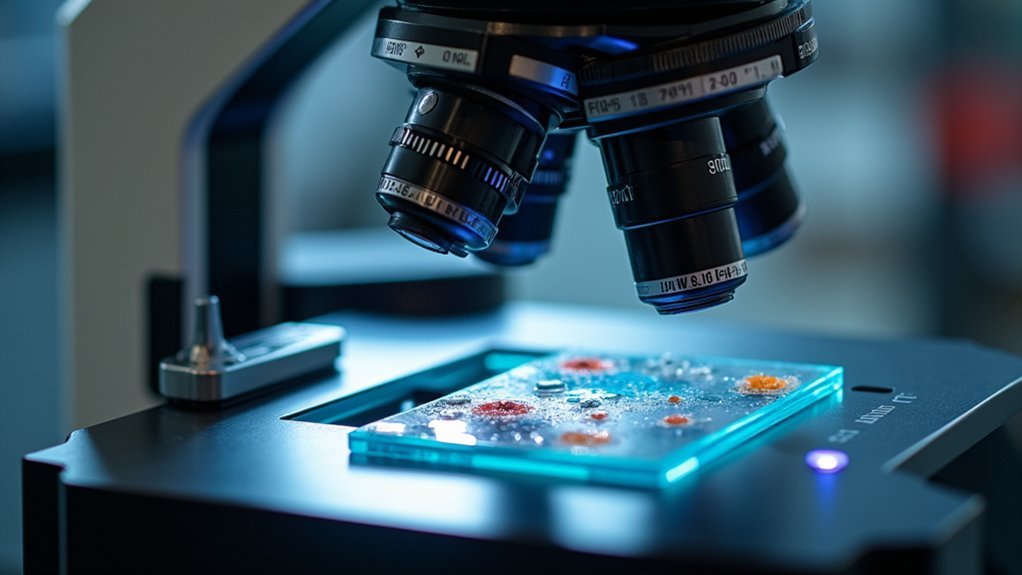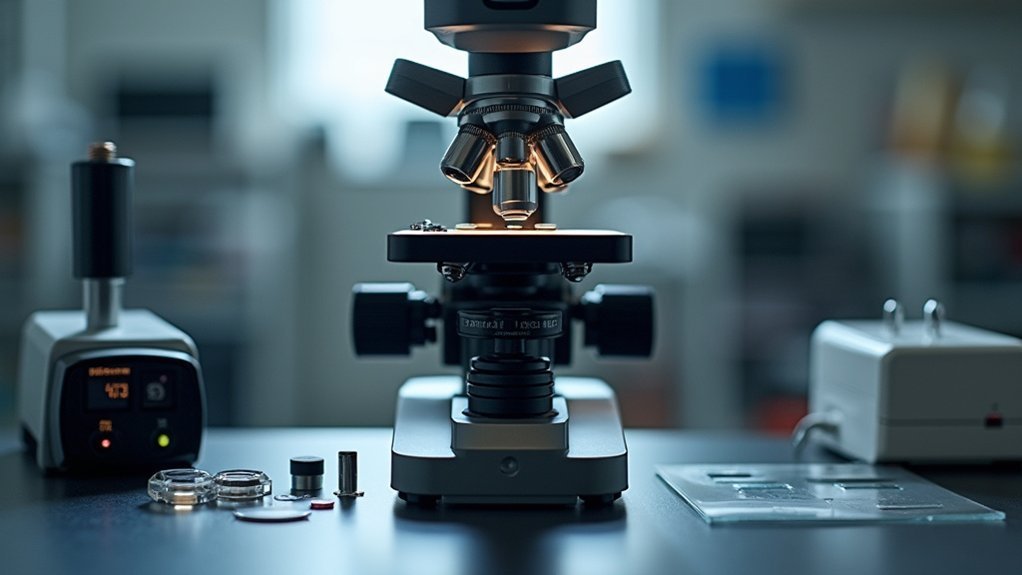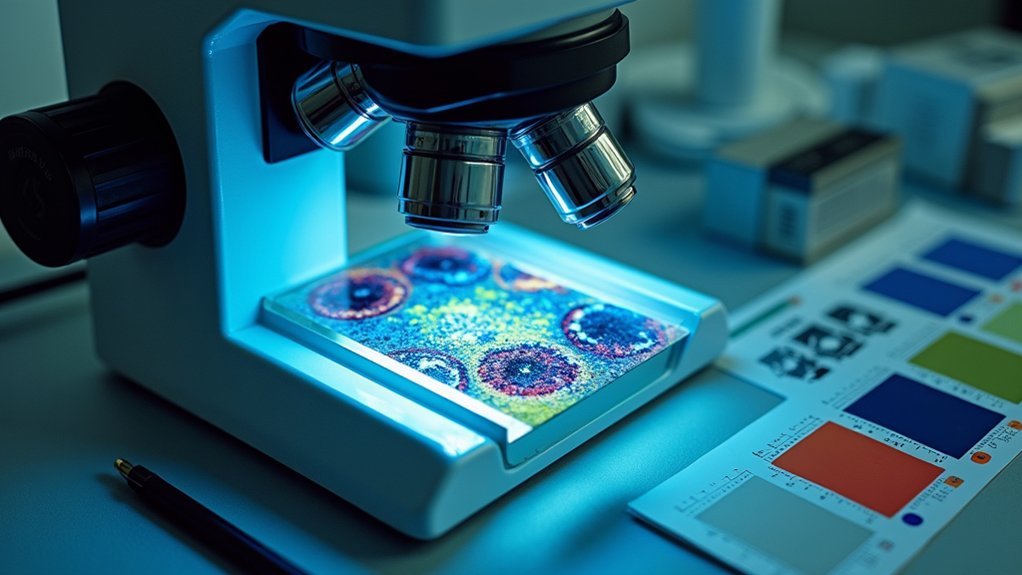Proper phase contrast calibration requires careful alignment of your condenser annulus with the objective’s phase plate. You’ll need to use a centering telescope to verify this alignment, adjust the condenser height, and optimize light intensity for clear contrast. Clean optical components regularly to prevent color artifacts and halos. Don’t forget to establish proper white balance using neutral reference slides. The following expert techniques will transform your microscope’s performance from adequate to exceptional.
Numeric List of Second-Level Headings

When calibrating phase contrast images, you’ll need to follow a systematic approach to guarantee ideal results.
Here’s a structured guide to secure optimal image quality:
- Align Phase Components
- Adjust Condenser Settings
- Position the Centering Telescope
- Fine-tune Background Light Intensity
- Verify with Test Slides
Each step plays a significant role in achieving proper contrast while minimizing optical artifacts.
Meticulous phase calibration ensures crisp detail visibility while eliminating distracting artifacts that compromise specimen analysis.
The alignment between phase rings and the condenser annulus is particularly important, as misalignment can lead to unwanted halos or distortions.
Pay special attention to the background light levels during calibration—too bright, and you’ll lose contrast; too dim, and details become obscured.
Regular verification using phase contrast test slides will guarantee your microscope maintains consistent performance for viewing transparent specimens.
Understanding Phase Contrast Principles for Accurate Color Reproduction
Although phase contrast microscopy primarily enhances structural visibility rather than color, understanding its fundamental principles is crucial for accurate color reproduction in your images. The technique works by converting refractive index differences into visible contrast, allowing you to observe transparent specimens without staining.
Your objective lenses contain phase rings that create the necessary phase shift, directly influencing both contrast and color representation. For ideal results, the condenser and phase rings need to be matched and properly aligned to minimize optical artifacts like halos that can distort color fidelity.
Pay close attention to light intensity calibration and focus adjustments, as these factors considerably impact image clarity and color accuracy.
Regular maintenance of your microscope’s optical components guarantees consistent performance and reliable color reproduction over time.
Essential Components for Phase Contrast Calibration

To properly calibrate your phase contrast microscope, you’ll need a matching condenser annulus and objective phase plate designed to work together as an integrated optical system.
You must guarantee perfect alignment between the condenser ring and the phase plate in the objective using a centering telescope, which directly impacts your image quality and the elimination of optical artifacts.
Your illumination system’s setup, including light source intensity and condenser position, plays an essential role in producing consistent, high-contrast images of transparent specimens.
Essential Components for Phase Contrast Calibration
Successful phase contrast microscopy depends entirely on properly calibrated optical components working in precise harmony. You’ll need to guarantee your microscope includes these critical elements and that they’re properly matched and aligned.
| Component | Function |
|---|---|
| Condenser Annulus | Creates hollow cone of light; must match objective’s phase ring |
| Phase Plate | Located in objective’s rear focal plane; manipulates light paths |
| Phase Contrast Objectives | Contains specific phase rings for different magnifications |
| Centering Telescope | Aids in precise alignment of annulus with phase ring |
| Maintenance Tools | Guarantees consistent calibration through regular checks |
Remember to regularly check the alignment between your condenser annulus and the objective’s phase ring using the centering telescope. This critical adjustment will dramatically improve your image quality by enhancing contrast based on refractive index differences in your specimen.
Annulus-Phase Plate Alignment
Perfect phase contrast imaging hinges on the precise alignment between your condenser annulus and the phase plate in your objective lens. This critical relationship guarantees ideal contrast while minimizing unwanted artifacts like halos around high phase shift details.
To achieve proper alignment, you’ll need to position the phase ring in the objective’s rear focal plane. Use a centering telescope to verify and adjust this alignment—this isn’t optional but essential for quality results. Make this check part of your regular microscopy routine.
Before examining actual specimens, validate your calibration with a phase contrast test slide. This confirms you’ve correctly aligned both components and helps maintain consistent imaging quality.
When properly configured, you’ll transform transparent specimens into high-contrast, detailed images with minimal optical distortion.
Illumination System Setup
With your annulus and phase plate properly aligned, your attention must now turn to the illumination system—the backbone of effective phase contrast microscopy.
A properly calibrated illumination setup guarantees consistent image quality and maximizes the contrast of transparent specimens.
To achieve ideal illumination:
- Verify your light source is stable and free from fluctuations that can compromise image quality.
- Align the light source precisely with the phase contrast condenser, as misalignment directly affects resolution.
- Open the phase aperture to its maximum position to allow sufficient light through the condenser.
- Clean and maintain all optical components regularly, including the light source, condenser, and phase rings.
Proper calibration should include verifying component alignment and adjusting light intensity for ideal contrast visualization of your specimens.
Pre-Calibration Checklist: Preparing Your Microscope System

Prior to calibrating your phase contrast microscope, you’ll need to inspect all essential components, including the condenser, objective lenses, and phase rings, for cleanliness and proper alignment.
Check your light source to guarantee optimal illumination intensity and confirm it’s correctly centered, as uneven lighting will compromise image quality.
Adjust the condenser height and aperture settings to the manufacturer’s specifications for your specific objective magnification to establish favorable conditions for phase contrast imaging.
Pre-Microscope Component Inspection
Before you begin the calibration process, a thorough inspection of all phase contrast components is vital to prevent common imaging problems.
Make sure you’re working with clean, properly matched parts for peak results.
- Examine the condenser annulus – Verify it’s the correct type for your objectives and free of dust or debris that could scatter light and reduce contrast.
- Check objective-phase ring compatibility – Confirm your phase contrast objectives properly align with corresponding phase rings to avoid ghosting or low contrast.
- Test your illumination source – Make certain of stable, bright lighting with consistent output; fluctuations will directly impact image quality.
- Verify centering telescope alignment – Proper centering of phase rings is critical for achieving highest contrast and resolution in your final images.
Light Source Assessment
The quality of your phase contrast images depends greatly on proper illumination. Before calibrating, make sure your light source delivers stable, adequate intensity for ideal contrast.
Check that it’s properly aligned with the microscope’s optical axis—even minor misalignments can greatly degrade image quality.
Monitor for any fluctuations in light output that might compromise image consistency. These variations often require immediate adjustment of your source settings.
Examine bulbs and filters for dust, fingerprints, or damage that could impede effective illumination. Clean components as needed using appropriate methods.
Finally, verify you’re using the correct wavelength for your specific phase contrast technique. Different applications may require distinct lighting conditions.
Taking these steps will establish the foundation for successful phase contrast imaging and prevent common illumination-related artifacts.
Aligning Phase Rings and Condenser Annuli for Optimal Contrast
While many microscopists focus on sample preparation, proper alignment of phase rings with condenser annuli serves as the foundation for successful phase contrast imaging.
You’ll need to guarantee precise positioning of the phase ring in the objective’s rear focal plane to maximize phase shifts in transparent specimens.
For ideal results:
- Adjust your condenser to the correct height, creating proper alignment between the annulus and phase ring.
- Use a centering telescope to verify alignment regularly.
- Make small adjustments to the condenser position until perfect concentricity is achieved.
- Check alignment periodically during extended imaging sessions.
Even minor misalignments can greatly reduce contrast and resolution.
Color Balance Techniques Specific to Phase Contrast Imaging

Proper white balance adjustments are essential when you’re working with phase contrast imaging to distinguish subtle cellular features from background artifacts.
You’ll achieve more accurate specimen representation by calibrating your microscope’s color temperature settings before each imaging session, ensuring that transparent structures appear with their true optical properties.
Optimizing your contrast range further enhances these benefits by expanding the visible differences between phases, allowing you to capture fine structural details that might otherwise remain indistinguishable.
White Balance Adjustments
In phase contrast microscopy, accurate white balance calibration represents a vital step that many researchers overlook.
When you’re examining transparent specimens, proper white balance guarantees true color representation without distracting color casts that might hide essential details.
For peak white balance calibration:
- Use a neutral gray reference card in your field of view to establish a balanced color baseline.
- Regularly recalibrate when changing light sources or filters to maintain consistency.
- Leverage software tools that offer real-time adjustments for immediate visual feedback.
- Pay special attention to subtle refractive index differences which become more visible with proper calibration.
Contrast Range Optimization
Beyond white balance considerations, contrast range refinement forms the backbone of detailed phase contrast imaging.
You’ll achieve superior contrast by guaranteeing proper alignment between the phase rings in your objective lenses and the condenser annulus. This alignment is critical for enhancing transparent specimen visibility.
Adjust your light intensity through the source controls to balance illumination—this directly impacts both contrast and sample visibility.
For post-processing enhancement, utilize color balance techniques in your imaging software to fine-tune hues and saturation, making structural details more distinct.
Implement gamma and brightness adjustments to enhance the dynamic range of your contrast.
Don’t neglect regular calibration using standardized test slides to verify accurate phase shifts without excessive artifacts.
These practices guarantee your phase contrast images maintain superior contrast range for scientific analysis.
Compensating for Halo Effects in Phase Contrast Photography
While phase contrast microscopy offers remarkable visualization of transparent specimens, the unwanted halo effects surrounding cellular structures can greatly compromise image quality and interpretation.
You’ll need a systematic approach to minimize these optical artifacts and reveal true specimen details.
- Align optical components precisely – Guarantee perfect alignment between phase rings and condenser annulus to prevent exacerbating halo artifacts.
- Maintain clean optics – Regularly inspect and clean phase plates and objectives to reduce light scattering that intensifies halos.
- Select appropriate objectives – Use higher numerical aperture phase contrast objectives when possible for improved resolution and reduced halo visibility.
- Enhance illumination settings – Adjust light intensity and condenser height to find the best balance that minimizes halos while maintaining contrast.
Software Tools for Phase Contrast Color Correction

Although phase contrast imaging excels at revealing transparent structures, you’ll often need specialized software tools to correct color distortions and enhance image quality.
Modern software packages provide essential histogram adjustments that let you fine-tune pixel intensity distribution for improved clarity and detail representation.
When calibrating your images, look for tools with automated color correction algorithms that mitigate halos and optical artifacts while reducing user error.
These features streamline your workflow and guarantee consistent results. Many applications also offer brightness, contrast, and color balance adjustments specifically designed for transparent specimens.
For more advanced analysis, consider software that integrates fluorescence channels with phase contrast images.
This capability enables simultaneous observation of different cellular signals, making comparative studies of structures and functions remarkably more effective.
Standardizing White Balance in Phase Contrast Microscopy
Software tools provide powerful correction capabilities, but proper image calibration begins with accurate white balance settings.
To guarantee transparent specimens remain clearly visible without color casts, you’ll need to standardize this critical parameter.
- Start with a calibrated white reference slide under identical illumination conditions – this establishes your baseline for consistent adjustments across imaging sessions.
- Match your camera settings to your light source’s color temperature (typically 5500K for daylight-balanced microscopy illumination).
- Recalibrate whenever ambient lighting changes or when switching between different sample types to maintain color accuracy.
- Implement a regular maintenance schedule that includes white balance standardization to guarantee reproducible, reliable phase contrast images.
Remember that proper white balance is fundamental to capturing true specimen detail and enhancing the scientific value of your microscopy work.
Troubleshooting Color Artifacts in Phase Contrast Images
Despite careful white balance calibration, unwanted color artifacts can still plague phase contrast images, manifesting as colored halos around high phase shift details. These artifacts can obscure vital specimen features but can be minimized through proper microscope maintenance.
| Issue | Cause | Solution |
|---|---|---|
| Colored halos | Misaligned phase rings | Precisely realign condenser and phase rings |
| Rainbow effects | Dirty optical components | Clean phase rings and lenses regularly |
| Color distortion | Unstable light source | Adjust intensity and guarantee stable illumination |
Use a phase contrast test slide to diagnose alignment problems contributing to artifacts. Regular cleaning prevents debris accumulation that causes distortion. Remember that proper alignment of phase rings and condenser settings isn’t just for ideal contrast—it’s essential for eliminating distracting color artifacts that might compromise your specimen analysis.
Frequently Asked Questions
How to Set up Phase Contrast?
To set up phase contrast, you’ll need to open the phase aperture fully, select pH mode in software, confirm turret alignment matches your objective, rotate phase turret if prompted, and verify image quality afterward.
How Do You Get a Good Image Under Phase Contrast Microscope?
To get a good phase contrast image, you’ll need to align your phase rings properly, adjust light intensity, and fine-tune your focus. Don’t forget to use the centering telescope for perfect ring alignment.
What Is the Phase Centering Telescope on a Nikon?
A phase centering telescope on your Nikon microscope helps you align phase rings in the objective and condenser. You’ll insert it into the eyepiece tube to visualize and center both rings for maximum contrast imaging.
Which Lens Is Used in a Phase Contrast Microscope?
You’ll use phase contrast objectives with built-in phase plates in a phase contrast microscope. These specialized lenses contain phase rings that work with matching condenser annuli to enhance contrast in transparent specimens.
In Summary
You’ve now mastered the essentials of phase contrast calibration for accurate color reproduction. By properly aligning your system, compensating for halos, and standardizing white balance, you’ll consistently produce high-quality images. Remember, regular maintenance and proper troubleshooting techniques are your best allies. Apply these specialized tools and methods to your workflow, and you’ll elevate your phase contrast microscopy to professional standards.





Leave a Reply